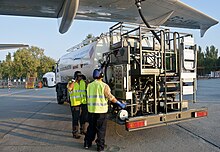
Back Biokerosin German Biocombustibles para la aviación Spanish سوخت زیستی هوانوردی Persian Biocarburant pour l'aviation French Biogoriva u zračnom prometu Croatian Bahan bakar hayati aviasi ID 航空バイオ燃料 Japanese Jet biyoyakıtı Turkish

An aviation biofuel (also known as bio-jet fuel[1] or bio-aviation fuel (BAF);[2]) is a biofuel used to power aircraft and is a sustainable aviation fuel (SAF). The International Air Transport Association (IATA) considers it a key element in reducing the environmental impact of aviation.[3] Aviation biofuel is used to decarbonize medium and long-haul air travel. These types of travel generate the most emissions, and could extend the life of older aircraft types by lowering their carbon footprint. Synthetic paraffinic kerosene (SPK) refers to any non-petroleum-based fuel designed to replace kerosene jet fuel, which is often, but not always, made from biomass.
Biofuels are biomass-derived fuels from plants, animals, or waste; depending on which type of biomass is used, they could lower CO2 emissions by 20–98% compared to conventional jet fuel.[4] The first test flight using blended biofuel was in 2008,and in 2011, blended fuels with 50% biofuels were allowed on commercial flights. In 2023 SAF production was 600 million liters, representing 0.2% of global jet fuel use.[5]
Aviation biofuel can be produced from plant or animal sources such as Jatropha, algae, tallows, waste oils, palm oil, Babassu, and Camelina (bio-SPK); from solid biomass using pyrolysis processed with a Fischer–Tropsch process (FT-SPK); with an alcohol-to-jet (ATJ) process from waste fermentation; or from synthetic biology through a solar reactor. Small piston engines can be modified to burn ethanol.
Sustainable biofuels are an alternative to electrofuels.[6] Sustainable aviation fuel is certified as being sustainable by a third-party organisation.
SAF technology faces significant challenges due to feedstock constraints. The oils and fats known as hydrotreated esters and fatty acids (Hefa), crucial for SAF production, are in limited supply as demand increases. Although advanced e-fuels technology, which combines waste CO2 with clean hydrogen, presents a promising solution, it is still under development and comes with high costs. To overcome these issues, SAF developers are exploring more readily available feedstocks such as woody biomass and agricultural and municipal waste, aiming to produce lower-carbon jet fuel more sustainably and efficiently.[7]
- ^ "Sustainable aviation fuel market demand drives new product launches". Investable Universe. 2020-12-04. Retrieved 2022-12-12. Note: Investable Universe>About
- ^ Doliente, Stephen S.; et al. (10 July 2020). "Bio-aviation Fuel: A Comprehensive Review and Analysis of the Supply Chain Components" (PDF). Frontiers in Energy Research. 8. doi:10.3389/fenrg.2020.00110.
- ^ "Developing Sustainable Aviation Fuel (SAF)". IATA.
- ^ Bauen, Ausilio; Howes, Jo; Bertuccioli, Luca; Chudziak, Claire (August 2009). "Review of the potential for biofuels in aviation". CiteSeerX 10.1.1.170.8750.
- ^ IATA (December 2023). "Net zero 2050: sustainable aviation fuels – December 2023". www.iata.org/flynetzero. Archived from the original on 24 February 2024.
- ^ Mark Pilling (2021-03-25). "How sustainable fuel will help power aviation's green revolution". Flight Global.
- ^ "New Technology Helps Advance Non-Hefa SAF Projects". Energy Intelligence. 2024-05-10. Retrieved 2024-05-14.
© MMXXIII Rich X Search. We shall prevail. All rights reserved. Rich X Search